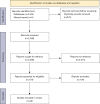Gait assessment tools for degenerative cervical myelopathy: a systematic review
- PMID: 35441108
- PMCID: PMC8990400
- DOI: 10.21037/jss-21-109
Gait assessment tools for degenerative cervical myelopathy: a systematic review
Abstract
Background: Degenerative cervical myelopathy (DCM) is a common progressive neurological disorder which may affect one's activities of daily living or even result in paraplegia/tetraplegia if left untreated. Currently, there is lack of consensus of the gait assessment tools for DCM. This systematic review aims to (I) provide an appraisal of the psychometric properties of the available gait assessment tools for DCM, (II) to assess their methodological quality according to The Consensus-based Standards for the selection of health Measurement COSMIN risk of bias checklist and (III) to assess each measurement property result against externally validated criteria.
Methods: Six electronic full-text databases [PubMed (via NLM® database], Medline (via OvidSP), CINAHL (via Ebsco), EMBASE (via Ovid), PsycINFO (via CSA) and Web of Science (via Thomson Reuters)] were systematically searched from inception to June 2020. The methodological quality of each study was analysed using the COSMIN risk of bias checklist. The measurement property result and methodological quality of each study were evaluated.
Results: Twenty studies were included from 3,339 citations retrieved. Twelve assessment tools for assessing gait in DCM were identified. According to COSMIN criteria, only five studies (25%) included in this review were found to have "very good" methodological quality. For construct validity, five tools had "sufficient" quality. For reliability, two assessment tools [the Total modified Japanese Orthopaedic Association Score (Italian Translation) (mJOA-ITTotal) and the modified Japanese Orthopaedic Association (Italian Translation) Motor dysfunction of the Lower Extremity (mJOA-ITMDLE)] were rated as "sufficient" for interobserver reliability while six assessment tools (the 10 second step test (10 sec ST), 30 minute walk test (30MWT), foot tapping test, mJOA-ITTotal, mJOA-ITMDLE and the Japanese Orthopaedic Association Cervical Myelopathy Evaluation Questionnaire) were rated as "sufficient" for test-retest reliability. The JOA (6 scores) received a "sufficient" rating for internal consistency. No assessment was available for responsiveness, as only the effect size was available.
Discussion: Based upon current evidence, the mJOA in combination with an objective functional test (i.e., 30MWT) is recommended for clinicians assessing gait in DCM, although this may change with an increase in the number of studies completed. Given the importance of assessment tools possessing adequate measurement properties, a focus on studies in this area is warranted.
Keywords: Measurement properties; cervical myelopathy; cervical spondylosis; gait assessment; spinal stenosis.
2022 Journal of Spine Surgery. All rights reserved.
Conflict of interest statement
Conflicts of Interest: All authors have completed the ICMJE uniform disclosure form (available at https://jss.amegroups.com/article/view/10.21037/jss-21-109/coif). The series “Objective Monitoring and Wearable Technologies including Sensor-Based Accelerometers and Mobile Health Applications for the Spine Patient” was commissioned by the editorial office without any funding or sponsorship. WJC serves as an Assistant Managing Editor of Journal of Spine Surgery. The authors have no other conflicts of interest to declare.
Figures
Similar articles
-
Reliability of a Smartphone App to Objectively Monitor Performance Outcomes in Degenerative Cervical Myelopathy: Observational Study.JMIR Form Res. 2024 May 24;8:e56889. doi: 10.2196/56889. JMIR Form Res. 2024. PMID: 38787602 Free PMC article.
-
Psychometric properties of the 30-m walking test in patients with degenerative cervical myelopathy: results from two prospective multicenter cohort studies.Spine J. 2017 Feb;17(2):211-217. doi: 10.1016/j.spinee.2016.08.033. Epub 2016 Aug 31. Spine J. 2017. PMID: 27592193
-
Clinical outcome measures and their evidence base in degenerative cervical myelopathy: a systematic review to inform a core measurement set (AO Spine RECODE-DCM).BMJ Open. 2022 Jan 19;12(1):e057650. doi: 10.1136/bmjopen-2021-057650. BMJ Open. 2022. PMID: 35046007 Free PMC article.
-
Psychometric analysis and critical appraisal of the original, revised, and modified versions of the Japanese Orthopaedic Association score in the assessment of patients with cervical spondylotic myelopathy.Neurosurg Focus. 2016 Jun;40(6):E6. doi: 10.3171/2016.3.FOCUS1648. Neurosurg Focus. 2016. PMID: 27246489 Review.
-
Validation of a translated version of the modified Japanese Orthopedic Association (mJOA) cervical myelopathy score in an Arabic speaking population.SICOT J. 2021;7:50. doi: 10.1051/sicotj/2021043. Epub 2021 Sep 14. SICOT J. 2021. PMID: 34542402 Free PMC article.
Cited by
-
Reliability of a Smartphone App to Objectively Monitor Performance Outcomes in Degenerative Cervical Myelopathy: Observational Study.JMIR Form Res. 2024 May 24;8:e56889. doi: 10.2196/56889. JMIR Form Res. 2024. PMID: 38787602 Free PMC article.
-
Metabolic changes of thalamus assessed by 1H-MRS spectroscopy in patients of cervical spondylotic myelopathy following decompression surgery.Front Neurol. 2025 Jan 8;15:1513896. doi: 10.3389/fneur.2024.1513896. eCollection 2024. Front Neurol. 2025. PMID: 39845933 Free PMC article.
-
Understanding degenerative cervical myelopathy in musculoskeletal practice.J Man Manip Ther. 2025 Jun;33(3):207-223. doi: 10.1080/10669817.2025.2465728. Epub 2025 Mar 4. J Man Manip Ther. 2025. PMID: 40035695 Free PMC article. Review.
-
Management of mild degenerative cervical myelopathy and asymptomatic spinal cord compression: an international survey.Spinal Cord. 2024 Feb;62(2):51-58. doi: 10.1038/s41393-023-00945-8. Epub 2023 Dec 21. Spinal Cord. 2024. PMID: 38129661 Free PMC article.
References
Publication types
LinkOut - more resources
Full Text Sources

